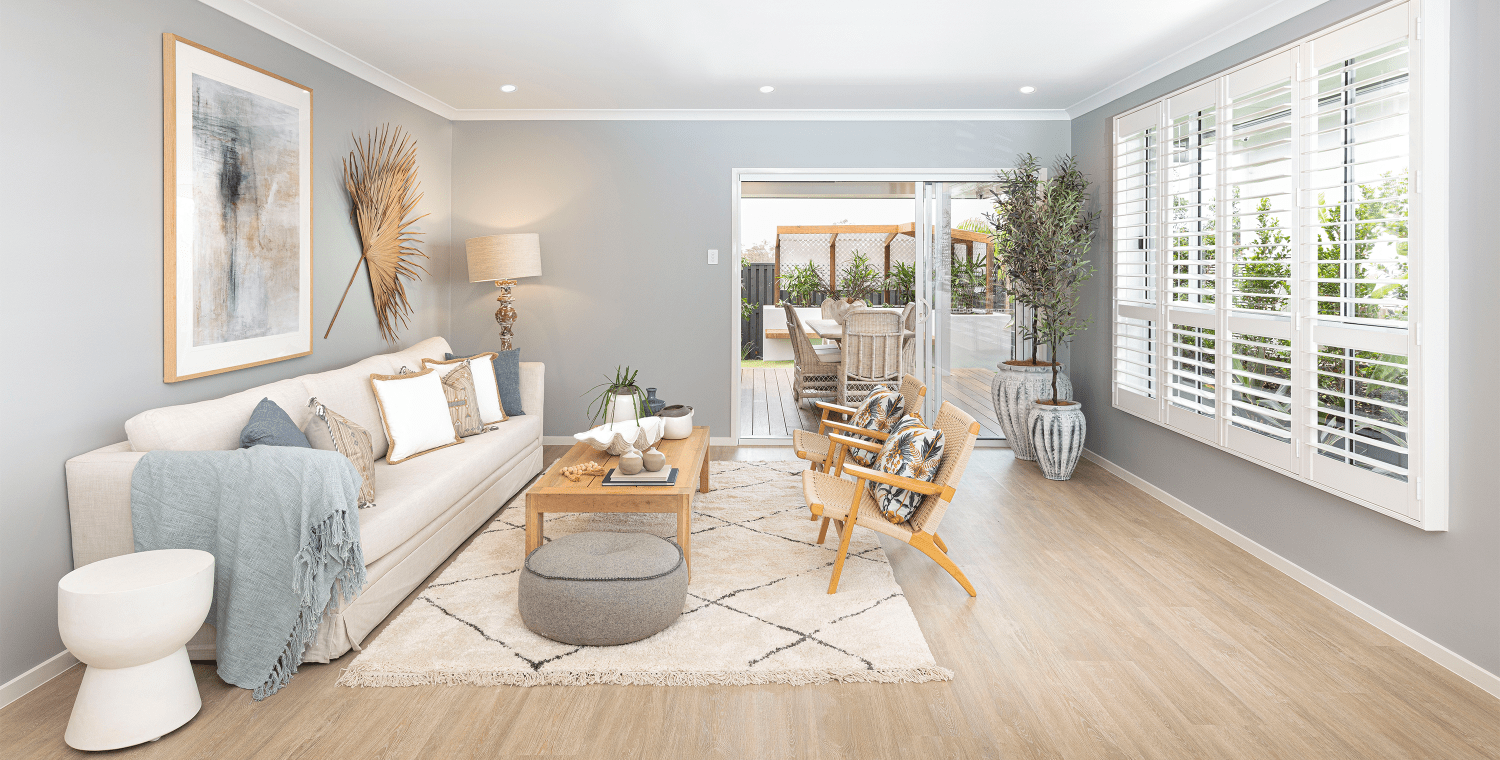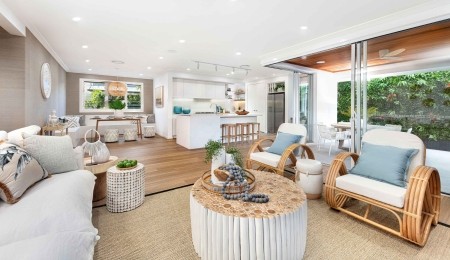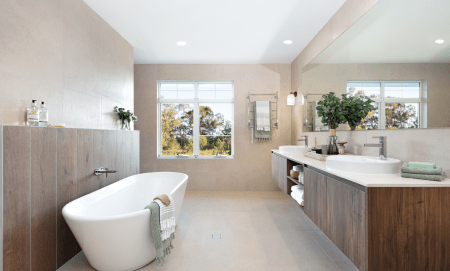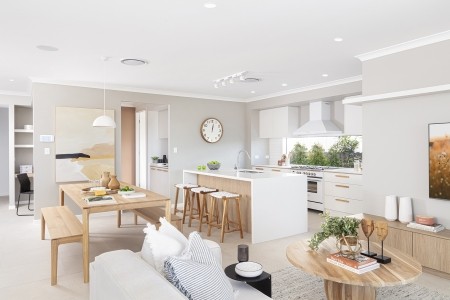What Is Feng Shui?

Feng Shui is an ancient Chinese practice that centres on creating harmony between people and their environment. Rooted in Chinese philosophy, it’s based on the idea that everything in a space carries energy – or chi – which can influence different parts of our lives, including health, wealth, relationships and more. Arranging furniture and using colours in a thoughtful way can optimise the flow of energy within your home and result in a more balanced and peaceful living environment.
The principles of Feng Shui have been used for thousands of years to guide home and workplace design. Indeed, plenty of modern homeowners here in Queensland use it as a tool to create spaces that are simultaneously pleasing to the eye while also in alignment with their personal aspirations.
What Is Feng Shui?
Feng Shui literally translates to “wind” and “water” and it's a practice that dates back over several thousands of years and is deeply rooted in Chinese philosophy. It’s based on the idea that the orientation and arrangement of a space can influence the flow of energy, and that by making specific design choices you can create a harmonious and prosperous environment with your surroundings.
One of the core parts of Feng Shui is balancing the five elements – wood, fire, earth, metal and water – within a home. Each of these elements represent a different energy and aspect of life, and their placement can influence your success and relationships, as well as your overall happiness. The presence of the wood element for example, which is symbolised by plants, relates to growth and vitality, while the fire element, represented by warm lighting or candles, can promote passion and enthusiasm.
Another core principle of Feng Shui is the Bagua Map, which is a tool used to divide a space into nine quadrants, each of which corresponds to different parts of life (e.g. health, career, relationships). Aligning rooms with the Bagua Map and using the right colours and elements can be helpful for homeowners who want to bring balance and positive energy into their spaces.
Benefits of Practicing Feng Shui
Experienced Feng Shui practitioners would advise that there are countless benefits to this practice that go beyond simple aesthetics. Carefully curating your space according to its principles has the capacity to improve your wellbeing, reduce stress, create an environment that supports your personal and professional goals, and much more.
A home with good chi, or energy circulation, feels more comfortable and inviting. Placing furniture thoughtfully and keeping pathways clear, for example, means positive energy can move more freely and improve the overall ambiance of the home.
Feng Shui also helps create a sense of calm and relaxation. This is because a well-balanced space promotes greater peace of mind, thereby reducing stress and fostering mental clarity. This is especially important in spaces like bedrooms and home offices, where relaxation and productivity should be encouraged.
Another top benefit is improved relationships. By arranging shared spaces with Feng Shui in mind, such as positioning seating to encourage face-to-face conversations, homeowners can foster stronger connections with family and guests.
Furthermore, Feng Shui is believed to attract prosperity and success. Aligning workspaces with the principles of Feng Shui, which might involve placing a desk in the commanding position, can promote career advancement and financial stability. Similarly, incorporating water elements in strategic areas of the home symbolises abundance and opportunity.
What is Bad Feng Shui for a House?
Just as Feng Shui can enhance a home’s energy, certain design choices can disrupt the flow of chi and create imbalance, including (but not limited to):
1. Cluttered spaces
One of the biggest Feng Shui no-nos is excessive clutter. Too much ‘stuff’ blocks energy flow and leads to the feeling of being overwhelmed. Keep spaces tidy and organised so that chi can move freely.
2. Poor bed placement
Placing the bed directly in line with the bedroom door is considered bad Feng Shui. Also called the ‘coffin position’, this placement means energy rushes towards the bed, which can disrupt your sleep.
3. Front and back doors in a straight line
If your front door is directly aligned with your back door, energy will rush through the house too quickly and stop it from nourishing the space. A simple fix is to place a decorative element, such as a rug or plant, in between to slow down the flow of energy.
4. Broken items and leaky taps
In Feng Shui, broken objects and leaking water symbolise wasted energy and resources. Keep your home well-maintained and fix anything that’s broken straight away.
5. Sharp angles, harsh lighting
Rooms with too many sharp angles or harsh lighting can drum up negative energy, which will make the space feel unwelcoming. Soften these areas with rounded furniture and natural elements like plants or flowing-water features.
6. Dark, neglected areas
Every part of a home should get the attention and care it deserves. Dark, forgotten corners or unused rooms can become stagnant energy zones and disrupt the overall harmony of your home.
Feng Shui Principles
Feng Shui masters believe in several fundamental principles that will help guide the arrangement of a home. These Feng Shui practices are all about promoting energy flow and forging harmony between different elements.
Chi
Chi, or life force energy, is completely intertwined with Feng Shui. It’s the invisible energy that moves through spaces and influences the overall atmosphere and how people feel within them. When chi is able to flow freely, it leads to balance, peace and vitality. But when chi is blocked or stagnant, it can result in discomfort and even misfortune.
In Feng Shui design, maintaining a good chi flow requires smart arrangement of the furniture and decor. Too much clutter, narrow hallways and overcrowded spaces can restrict chi’s movement, whereas open layouts and natural light can help direct and amplify positive energy.
Chi is also influenced by the quality of air and light. Fresh air from open windows and proper ventilation are all part of good Feng Shui and will contribute to a healthier, more energetic environment.
Commanding Position
The commanding position is a fundamental part of incorporating Feng Shui in your home as it dictates the best placement for important furniture pieces (e.g. beds, desks, stoves). The commanding position helps you to feel secure and in control, ultimately symbolising a sense of stability and awareness in life.
In a bedroom, the bed should be placed in a position that allows the occupant to see the door while lying down but not be directly in line with it. Such placement fosters a sense of security and relaxation.
For home offices, desks should also be positioned in a way that gives you a clear view of the entryway in order to promote focus, career advancement and leadership.
Bagua Map
The Bagua Map is a tool you can use to analyse the energy distribution in your home and spot which areas correspond to different aspects of life. The word Bagua means “eight areas” in Chinese, with each section representing an essential life element like wealth, career, health and relationships. At the centre of the Bagua map is Tai Qi, symbolising overall wellbeing and acting as the ninth quadrant.
To apply the Bagua Map to your home, overlay it onto the floor plan with the entrance aligned to the bottom of the grid. Depending on the school of Feng Shui you follow, the placement could be based on compass directions or the layout of the front door. Each section of the Bagua Map is associated with a specific colour, element and shape for its corresponding life aspect.
The Five Elements of Feng Shui
The five elements of Feng Shui – wood, fire, earth, metal and water – are necessary for achieving total harmony in any space. Each of these elements represents a different energy and emotion, so balancing them is the only way to create a well-rounded and positive atmosphere in the home.
Wood: Wood symbolises growth, renewal and vitality, and it’s associated with wealth and new beginnings. Think about incorporating wooden furniture, green plants and vertical shapes to boost personal growth and financial prosperity.
Fire: Representing passion, creativity and transformation, fire is linked to reputation and fame. To incorporate the fire element, use red, orange and pink hues as well as candles and fireplaces to create an energised and motivating space.
Earth: Earth brings grounding energy and nourishment. It’s connected to health and relationships, so adding earthy tones, square shapes and natural materials like stone or ceramic can create a sense of stability.
Metal: As the embodiment of clarity and logic, metal is intended to enhance your organisation and help with relationships. Use white, grey, metallic accents and circular shapes to improve focus and structure.
Water: Water signifies wisdom, relaxation and abundance, and it’s strongly linked to career and emotional balance. Bring in curved shapes, mirrors, aquariums and deep blue or black tones to promote a calming, prosperous atmosphere.
What are the Feng Shui Colours?
Red (fire element): Passion, confidence, recognition. Best for living rooms or spaces where high energy is needed.
Green (wood element): Growth, health, renewal. Perfect for bedrooms, kitchens and study areas.
Blue (water element): Calmness, wisdom, relaxation. Works well in bedrooms and meditation spaces.
Yellow (earth element): Stability, warmth, nourishment. Great for shared areas like dining rooms and kitchens.
White (metal element): Purity, clarity, focus. Best for offices and bathrooms to encourage cleanliness and productivity.
Applying Feng Shui to Your Home
Feng Shui principles are used in interior design to create the most comfortable, harmonious living spaces possible.
To use Feng Shui in interior design, start with decluttering and organising each room to improve the energy flow. Arrange your furniture according to the commanding position and don’t place major items, like beds and desks, directly in line with doors. Use the
Bagua Map to determine where to emphasise different elements and colours to enhance each life area.
Incorporating natural elements like plants and water features can also generate more positive chi. The goal is to balance the five elements throughout the home while making sure each room serves its function well.
Tips for a Harmonious Home Environment
Decorate your plants
Some of the best Feng Shui plants include the money plant, bamboo, and peace lily, which attract positive energy and improve air quality. Be wary of plants with sharp or spiky leaves, as they can create harsh energy.
Consider the positions
Furniture placement is linked to energy flow, so beds and desks should be placed in the commanding position, facing the entrance but not directly aligned with it. Don’t set furniture in a way that blocks pathways, as this can cause energy to stagnate.
Balance colours
Using the right colour scheme based on the five elements work with different life areas. For example, while red is great for fame and reputation, blue promotes relaxation and wisdom. So, choose colours that align with your goals and the energy you want to cultivate.
Declutter
A cluttered space creates blocked energy and can cause stress. Keep your home organised so that chi can flow freely and make the space feel lighter and more inviting.
Fix broken things
Broken objects symbolise stagnation and energy loss, so fix the leaky tap or damaged door to prevent energy drains and support your financial and emotional stability.
Ready to Create Your Sanctuary?
While Brighton Homes is committed to crafting modern, functional spaces, we encourage homeowners to personalise their interiors with Feng Shui’s basic principles to create a truly harmonious sanctuary.
Looking for more inspiration? Check out our landscaping tips and ideas for your new home to complement your Feng Shui efforts.



